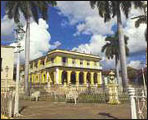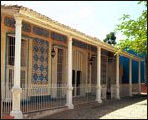The expeditionary Diego
Velazquez founded the city of Santisima Trinidad in 1514.
It was one of the first 7  cities
of the island founded by the Spaniards. In 1544 a large
number of the city's neighbors enrolled in the Hernan Cortes
army hoping to conquer Mexico. The city was therefore declared
officially depopulated. It wasn't until 1585 that the Spanish
population settled again in the region. cities
of the island founded by the Spaniards. In 1544 a large
number of the city's neighbors enrolled in the Hernan Cortes
army hoping to conquer Mexico. The city was therefore declared
officially depopulated. It wasn't until 1585 that the Spanish
population settled again in the region.
During the XVIIth and XVIIIth centuries, the development
of the city was partially interrupted by the frequent pirates'
attacks. Trinidad not only fought with its own militia,
but also had to establish a system of fleets to protect
its coasts of such incursions. The economic set-backs were
compensated by the illegal selling of the exquisite Tabaco
Trinitario, the contraband of salty meats, cattle and skins
with the neighboring ports of Jamaica and other Caribbean
islands. Moreover, Trinidad was the first entry port of
the island for African slaves and for several expensive
products such as alcohol, glassware, spices and sets of
dishes that could not be legally obtained in Cuba.
 Parallelly
to the Haitian anti-slave revolution of Toussan Louverture,
the Real Seat for Blacks was created to facilitate the import
of African slaves and to increase the interchanges of commercial
goods with Jamaica, country inserted in the english industrial
development. In just a short time, these actions contributed
to the fast development of Trinidad, positioning itself
between the main sugar production zones of the Carribean
and creating a city of luxury and palaces. Parallelly
to the Haitian anti-slave revolution of Toussan Louverture,
the Real Seat for Blacks was created to facilitate the import
of African slaves and to increase the interchanges of commercial
goods with Jamaica, country inserted in the english industrial
development. In just a short time, these actions contributed
to the fast development of Trinidad, positioning itself
between the main sugar production zones of the Carribean
and creating a city of luxury and palaces.
Around 1755, the city counts on an important economy with
262 block of houses, 32 streets, 25 sugar plants, 55 cattle
properties, 104 tobacco fertile valleys and 3 tile shops.
These are irrefutable proofs of its growth. It is for that
reason that from 1797 to 1850 the city became a government
possession, with political and military jurisdictions on
the large central territory of the island.
Between 1857 and 1866, the country goes through of one
its worse crisis. The anti-slaves rebellions combined with
the beginning, in 1868, of the 10-Year War, caused a decline
in the economic development of the city. As a result, the
rich landowners slowly began to leave the city. It did not
have railroads until 1919 and was not connected by means
of highways with the rest of the country until 1950, being
for always frozen in time.
Today, Trinidad's major economic activities are tourism,
crafts and tobacco.
|